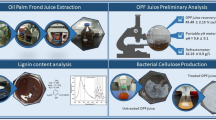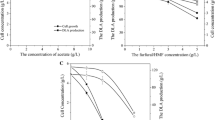Abstract
Five organic acids (acetic, ferulic, 4-hydroxybenzoic, formic and levulinic acids) typically associated in the hemicellulose hydrolysate were selected to study their effects on the xylitol fermentation. The effects of individual and combined additions were independently evaluated on the following parameters: inhibitory concentration; initial cell concentration; pH value; and membrane integrity. The results showed that the toxicities of organic acids were related to their hydrophobility and significantly affected by the fermentative pH value. In addition, it was revealed that the paired combinations of organic acids did not impose synergetic inhibition. Moreover, it was found that the fermentation inhibition could be alleviated with the simple manipulations by increasing the initial cell concentration, raising the initial pH value and minimizing furfural levels by evaporation during the concentration of hydrolysates. The proposed strategies for minimizing the negative effects could be adopted to improve the xylitol fermentation in the industrial applications.





Similar content being viewed by others
References
Liaw WC, Chen CS, Chang WS, Chen KP (2008) Xylitol production from rice straw hemicellulose hydrolyzate by polyacrylic hydrogel thin films with immobilized Candida subtropicalis WF79. J Biosci Bioeng 105:97–105
Wang L, Yang M, Fan XG, Zhu XT, Xu T, Yuan QP (2011) An environmentally friendly and efficient method for xylitol bioconversion with high temperature steaming corncob hydrolysate by adapted Candida tropicalis. Process Biochem 46:1619–1626
Rodrigues RCLB, Felipe MGA, Roberto IC, Vitolo M (2003) Batch xylitol production by Candida guilliermondii FTI 20037 from sugarcane bagasse hemicellulosic hydrolysate at controlled pH values. Bioprocess Biosyst Eng 26:103–107
Pereira SR, Mussatto IS, Roberto IC (2011) Inhibitory action of toxic compounds present in lignocellulosic hydrolysates on xylose to xylitol bioconversion by Candida guilliermondii. J Ind Microbiol Biotechnol 38:71–78
Sreenivas-Rao R, Pavana-Jyothi C, Prakasham RS, Sarma PN, Venkateswar-Rao L (2006) Xylitol production from corn fiber and sugarcane bagasse hydrolysates by Candida tropicalis. Bioresour Technol 97:1974–1978
Mussatto SI, Roberto IC (2004) Alternatives for detoxification of diluted-acid lignocellulosic hydrolyzates for use in fermentative processes: a review. Bioresour Technol 93:1–10
Mussatto SI, Roberto IC (2005) Evaluation of nutrient supplementation to charcoal-treated and untreated rice straw hydrolysate for xylitol production by Candida guilliermondii. Braz Arch Biol Technol 48:497–502
Sun Y, Cheng J (2002) Hydrolysis of lignocellulosic materials for ethanol production: a review. Bioresour Technol 83:1–11
Kuhad RC, Singh A (1993) Lignocellulosic biotechnology: current and future prospects. Crit Rev Biotechnol 13:151–172
Hähn-Hägerdal B (1996) Ethanolic fermentations of lignocellulose hydrolysates. Appl Biochem Biotechnol 57–58:195–199
Felipe MGA, Veira MV, Vitolo M, Mancilha IM, Roberto IC, Silva SS (1995) Effect of acetic acid on xylose fermentation to xylitol by Candida guilliermondii. J Basic Microbiol 35:171–177
Larsson S, Palmqvist E, Hähn-Hägerdal B, Tengborg C, Stenberg K, Zacchi G, Nilvebrant NO (1998) The generation of fermentation inhibitors during dilute acid hydrolysis of softwood. Enzyme Microb Technol 24:151–159
Yuan QP, Zhang H, Qian ZM, Yang XJ (2004) Pilot-plant production of xylo-oligosaccharides from corncob by steaming, enzymatic hydrolysis and nanofiltration. J Chem Technol Biotechnol 79:1073–1079
Pampulha ME, Loureiro-Dias MC (1989) Combined effect of acetic acid, pH and ethanol on intracellular pH of fermenting yeast. Appl Microbiol Biotechnol 31:547–550
Cortez VD, Roberto IC (2010) Individual and interaction effects of vanillin and syringaldehyde on the xylitol formation by Candida guilliermondii. Bioresour Technol 101:1858–1865
Delgenes J, Moletta R, Navarro JM (1996) Effects of lignocellulose degradation products on ethanol fermentations of glucose and xylose by Saccharomyces cerevisiae, Zymomonas mobilis, Pichia stipitis and Candida shehatae. Enz Microb Technol 19:220–225
Almeida JRM, Modig T, Petersson A, Hähn-Hägerdal B, Lidén G, Gorwa-Grauslund M (2007) Increased tolerance and conversion of inhibitors in lignocellulosic hydrolysates by Saccharomyces cerevisiae. J Chem Technol Biotechnol 82:340–349
Carvalho BMG, Mussatto IS, Cândido JE, Almeida e Silva BJ (2006) Comparison of different procedures for the detoxification of eucalyptus hemicellulosic hydrolysate for use in fermentative processes. J Chem Technol Biotechnol 81:152–157
Silva DDV, Felipe MGA, Manchilha IM, Luchese RH, Silva SS (2004) Inhibitory effect of acetic acid on bioconversion of xylose in xylitol by Candida guilliermondii in sugarcane bagasse hydrolysate. Braz J Microbiol 35:248–254
Zaldivar J, Martínez A, Ingram OL (1999) Effect of organic acids on the growth and fermentation of ethanologenic Escherichia coli LY01. Biotechnol Bioeng 65:203–210
Osman YA, Ingram LO (1985) Mechanism of ethanol inhibition of fermentation in Zymomonas mobilis strain CP4. J Bacteriol 164:173–180
Kima TW, Kimb DM, Choi CY (2006) Rapid production of milligram quantities of proteins in a batch cell-free protein synthesis system. J Biotechnol 124:373–380
Taherzadeh JM, Niklasson C, Liden G (1997) Acetic acid—friend or foe in anaerobic batch conversion of glucose to ethanol by Saccharomyces cerevisiae. Chem Eng Sci 52:2653–2659
Verduyn C, Postma E, Scheffers WA, Van-Dijken JP (1992) Effect of benzoic acid on metabolic fluxes in yeasts: a continuous culture study on the regulation of respiration and alcoholic fermentation. Yeast 8:501–517
Palmqvist E, Hähn-Hägerdal B (2000) Fermentation of lignocellulosic hydrolysates II: inhibitors and mechanisms of inhibition. Bioresour Technol 74:25–33
Helle S, Cameronb D, Lama J, White B, Duff S (2003) Effect of inhibitory compounds found in biomass hydrolysates on growth and xylose fermentation by a genetically engineered strain of S. cerevisiae. Enz Microb Technol 33:786–792
Lawford HG, Rousseau JD (1998) Improving fermentation performance of recombinant Zymomonas in acetic acid-containing media. Appl Biochem Biotechnol 70–72:161–172
Sakai S, Tsuchida Y, Okino S, Ichihashi O, Kawaguchi H, Watanabe T (2007) Effect of lignocellulose-derived inhibitors on growth of and ethanol production by growth arrested Coryne bacterium glutamicum R. Appl Environ Microbiol 73(7):2349–2353
Palmqvist E, Hähn-Hägerdal B, Galbe M, Zacchi G (1996) The effect of water-soluble inhibitors from steam-pretreated willow on enzymatic hydrolysis and ethanol fermentation. Enz Microb Technol 19:470–476
Hauptmann P, Lehle L (2008) Kex1 protease is involved in yeast cell death induced by defective N-glycosylation, acetic acid, and chronological aging. J Biol Chem 283:19151–19163
Rivard C, Engel R, Hayward T, Nagle N, Hatzis C, Philippidis G (1996) Measurement of the inhibitory potential and detoxification of biomass pretreatment hydrolyzate for ethanol production. Appl Biochem Biotechnol 57–58:183–191
Acknowledgments
We are indebted to the National High-tech Research and Development Program (2011AA02A207) and to the Natural Science Foundation of China (20976009, 21176018) for their generous financial supports.
Conflict of interest
None.
Author information
Authors and Affiliations
Corresponding author
Rights and permissions
About this article
Cite this article
Wang, L., Wu, D., Tang, P. et al. Effect of organic acids found in cottonseed hull hydrolysate on the xylitol fermentation by Candida tropicalis . Bioprocess Biosyst Eng 36, 1053–1061 (2013). https://doi.org/10.1007/s00449-012-0858-2
Received:
Accepted:
Published:
Issue Date:
DOI: https://doi.org/10.1007/s00449-012-0858-2




